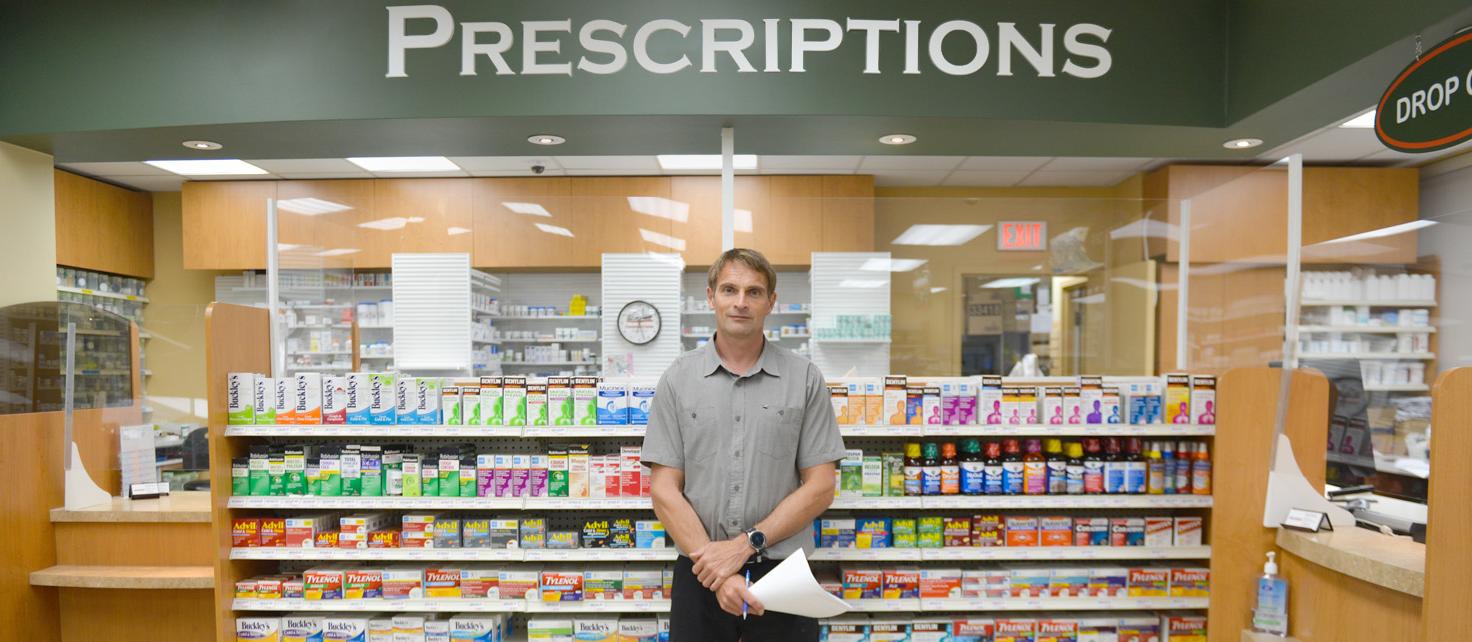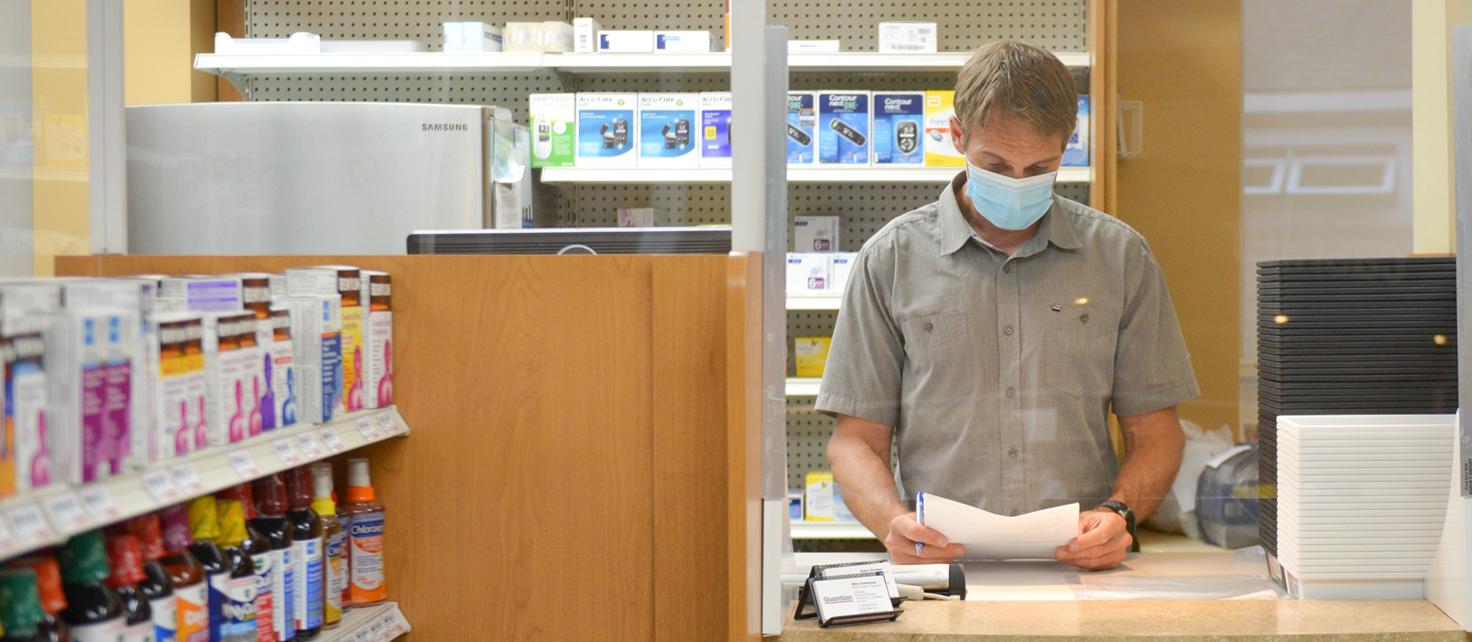Q&A with LDFP alumnus Mike Colebrook who describes his pharmacy’s radical transformation in response to COVID-19
Flashback to March 2020 to when the COVID-19 crisis hit Ontario. Millions of office workers started working from home. Elective surgeries were cancelled, patients met virtually with their medical specialist, and family doctors prioritized in-person appointments that required hands-on examination.
As the entire health system scrambled to modify services to support the stay-at-home mandate, pharmacists were among the only remaining front-line health professionals that could knowledgably address patients’ health questions.
Mike Colebrook (BScPhm ‘94) is a community pharmacist who thoughtfully transformed his workplace to maintain essential services for his community and fill a much-needed COVID-19 information gap. He did so while protecting his staff, running a profitable business, and keeping himself — and his patients — informed during a media firestorm.
Colebrook spoke with Leslie Dan Faculty of Pharmacy about his response to the unprecedented COVID-19 crisis and how he’s advocating for pharmacy practice reform across Ontario.
What happened on March 17 when Ontario declared COVID-19 an emergency?
When the state of emergency was declared, things seemed to change almost every day and we had to adapt immediately. There was very little guidance from any of the regulatory bodies (government, Ontario College of Pharmacists, etc.).
My business partner and I would often have late night discussions to figure out what we had to do next to ensure our staff and customers were safe. We immediately closed off the store to public access and operated through a plexiglass window. Nothing was accepted into the store unless it could be sterilized (or put aside for 3-5 days) and put into a Zip-Lok bag. Patients who had cell phones were instructed to wait in their car for a call when the order was ready. Most completed prescriptions and over-the-counter orders were brought out to the patient’s cars for curbside delivery.
Many doctors closed access for most of their patients, which put the burden on pharmacists to field an increased spectrum of questions while their doctor was unavailable. We also saw an increased need for advice to treat ailments, since many patients preferred to self-medicate rather than risk going to a walk-in clinic. During these counselling sessions, we also had to evaluate when further medical attention was necessary.
Can you describe how your day-to-day operations changed?
Our volume of phone calls and prescriptions drastically increased to the point that we did not have the staff to handle it. Every transaction took extra time since we often needed to select over-the-counter products for the patients, manually ring in credit cards and bring out the completed order to their car. Some customers would hold up the technicians on the phone asking them to select even the most unessential items such as birthday cards and chocolate bars.
Those who didn't have credit cards had to come to the entrance of the store where they could 'tap' a debit card or (only as a last resort) pay cash, which was handled with gloves and then sterilized with alcohol before being placed into the till. We also had to deal with multiple calls and visits per hour from customers looking to purchase personal protective equipment and items such as hand sanitizer, gloves, alcohol and thermometers, most of which had become totally unavailable. Some people would take their frustration out on us when they could not find these items.
“Being one of the most accessible health professionals, we quickly became the front-line service that dealt with the public's health concerns. People came to us first when they were sick since access to doctors and walk-ins became extremely limited.”
How did you ensure the safety of your staff?
The staff were concerned about their safety. Within days of the state of emergency being declared, we closed off public access to minimize risk of exposure at the work place but extra expectations were also placed on them to follow the isolation rules at home as well. Wage increases were given to all staff to help compensate for the extra responsibilities we placed on them.
How did you stay informed with credible, up-to-date COVID-19 information?
As the cases of COVID-19 grew, so did questions and concerns from patients. Information was rapidly changing and it was important to keep up daily (and sometimes hourly) to be able to provide patients with the most updated information and more importantly, try to filter out the misinformation.
Reliable sources were hard to find and we had to formulate advice compiling what we were learning using a variety of resources such as the media, Centre for Disease Control and Prevention, World Health Organization, etc. We were one of the front-line workers dealing with these questions and concerns as many members of the public came directly into the store or would call us by phone.
Was your supply chain affected?
Around the time that COVID-19 was declared a pandemic, we had to spend a lot of time keeping up with manufacturer supply updates and Ontario Drug Benefit policy as more and more patients demanded early refills and large quantities. We had many challenges dealing with patients who were trying to hoard medications who then became angry when we would deny their attempts to stockpile.
The stress on the pharmacy increased as broken supply chains started to cause supply issues. Some products were not available and most were allocated based on previous ordering history with maximum supplies being sent only based on dispensing a one-month supply. In some cases, only a one-week supply was allocated.
Did your location in Coldwater, Ontario play a role?
Allocation placed a specific stress on our pharmacy since we are located in cottage country. We had an increased volume due to many people leaving the city and isolating themselves at their cottages. Additional supplies of medications were needed at our location, but we were only being allocated based on our historical usage and no concessions were being made by wholesalers or manufacturers for our disproportionate increase in demand. Delivery was also a challenge due to the large geographical area that we service with many patients travelling long distances to use our pharmacy.
How did you fulfil prescription requests?
Much time was spent on trying to find alternatives for patients before their supply ran out or being able to fill only part of the prescription, then having to keep track of the owing to be filled when the remainder of the product (hopefully) arrived.
We often had to owe medications and hope that a balance would come in before the patient ran out. At times, we were faced with the task of prioritizing dispensing medications (such as puffers) to those patients who we knew had more severe life threatening conditions and couldn't go without while making others wait.
What action(s) did the government take to address stockpiling?
The government implementing the 30-day supply guideline helped stabilize the supply issues, but resulted in a further increase in volume and customer complaints (some customers accused pharmacies of gouging with extra fees).
Then in mid-June, the Ontario Drug Benefit unexpectedly opened up 90-day supplies with only about three-days warning (over a weekend), which resulted in a flood of prescription requests for a three-month supply since:
- Patients already on 30-day supply were all coming due;
- Those who had got 90-day supply in March were due;
- Some patients did not want to pay extra for 30 days so simply didn't take their meds properly or went without, then wanted their refills as soon as the 90-day supply opened back up;
- In cottage country, there was an extra demand from cottagers since in previous years, they would get three months from their home pharmacy, which would last all summer, but most of these patients only got 30 days so were calling us to transfer their meds from the city.
This rush for 90-day supply then once again resulted in drug shortages and staffing was extremely hard to manage since mid-June to mid-July had unprecedented demand followed by abnormally low volume since most patients had received a 90-day supply within a 30-day period.
Did you engage in any government advocacy efforts?
When the government was deciding how to handle the negative feedback they were getting about dispensing 30 days, I sent a letter to the Minister of Health asking her to leave it up to the individual pharmacy's discretion whether to charge or not on the third dispensing event.
In the letter, I explained the increased costs and challenges associated with keeping our essential service running as one of the most accessible health professionals during the pandemic. I called for a show of support and appreciation to pharmacists by giving us the ability to be compensated for our services on the third event, which would send the message that our services are worth paying for.
What happened once masks were mandated in July?
Once Simcoe County made masks mandatory, we felt that we could look at reopening the doors. This required a total enclosure of the dispensary with plexiglass. Sanitizer stations were installed at entry and exit and physical distancing markings were laid out. Masks and sanitizer were also supplied to the staff.
The cost has been thousands for the renovations to shut off access to the store, then open up with the dispensary enclosed, and to provide personal protective equipment and sanitation supplies.
This is the way we are currently operating and as long as the cases stay low, we feel we can continue to operate this way until the pandemic ends, which could be many months or potentially years.
What are the most common questions or concerns you hear from customers?
Educating customers about the importance of wearing a mask, hand sanitizing and physical distancing when entering the store will continue to be a challenge with some people and this message will have to be continuously reinforced if the public becomes complacent or ‘fed up' with the rules and restrictions.
We are going to have to be constantly monitoring COVID-19 cases in our area and drug supply issues, adapting as necessary and if needed, closing off public access again.
We are also going to have to deal with the constant question of 'is this the next pandemic' each time a new virus or bacteria is reported.
What do you think is the future for pharmacists in a post-COVID-19 world
I feel that our pharmacy will continue to maintain practices such as extra hand-washing and physical distancing, particularly with patients who are sick.
We have to be prepared to continue answering questions from customers that are hyper-aware of emerging diseases and to understand some of the mental health issues when counselling patients as a result of the stress and other changes made during the pandemic.
Hopefully we go another 100 years before another pandemic, but if it happens again in my lifetime, I feel that our pharmacy staff and community have the knowledge and tools to more quickly implement measures to prevent transmission such as isolating at home, physical distancing, wearing masks and sanitizing.
Hopefully we don't all forget.
More News
Image

How Bebe Simelane’s summer research is fueling her passion for science
Through hands-on research, mentorship, and exposure to cutting-edge tools like AI, this USRP student is gaining the skills and confidence to pursue graduate studies and advance science.
Read More
Image

Faces of PharmSci: Kristy Scarfone
Co-supervised by Professor Jillian Kohler and Assistant Professor Jaris Swidrovich, MSc student Kristy Scarfone is researching how unregulated substance-related care and harm reduction vary across Ontario, with the goal of strengthening public health and showcasing pharmacists’ impact in this area.
Read More
Image

Research team aims to co-design diabetes and dementia support programs that meet community needs
Network for Health Populations funding will support collaborative project to improve health outcomes for immigrant communities in Mississauga.
Read More

